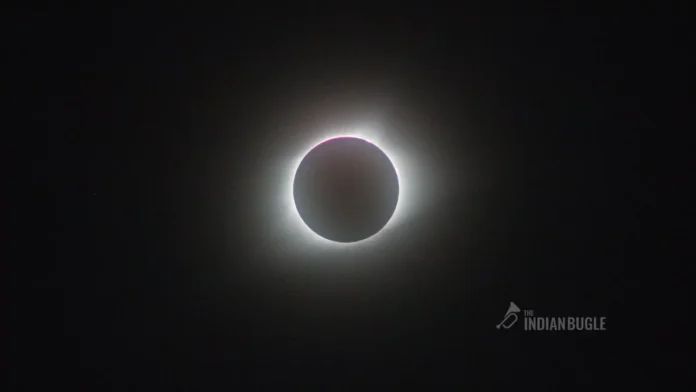On April 8, 2024, the skies over North America will play host to a celestial marvel – the Great North American Eclipse. This rare event will cast a shadow along a southwest-to-northeast path, turning day into night for a fleeting, magical moment.
What is a Total Solar Eclipse?
A total solar eclipse occurs when the moon aligns perfectly with the sun, blocking its light and creating a period of darkness. During this phenomenon, the sun’s outer layer, known as the corona, becomes visible. This captivating event not only intrigues skygazers but also impacts wildlife behavior, with nocturnal creatures stirring and birds falling silent.
The corona, an outer layer of the sun’s atmosphere, is usually hidden by the sun’s bright surface. During a total solar eclipse, this elusive corona is unveiled, allowing scientists a rare opportunity to study its structure.
Path of Totality: From Mexico to Canada
The 115-mile-wide path of totality will sweep across North America, spanning Mexico, the United States, and Canada. The eclipse is expected to begin on Mexico’s Pacific coast at approximately 11:07 a.m. PDT, with the longest duration near Torreon, Mexico, lasting an impressive 4 minutes and 27 seconds.
To visualize the precise path of totality, an interactive map by French eclipse expert Xavier Jubier provides a detailed overview.
Cities in the United States on the Eclipse Path
In the United States, 31 million people already reside within the path of totality. As the moon’s shadow progresses northeast, the eclipse will commence in Texas and traverse diagonally across the country, eventually reaching the maritime provinces of Canada. The Great North American Eclipse will pass through 13 U.S. states, including Texas, Arkansas, Missouri, Kentucky, Illinois, Indiana, Ohio, Pennsylvania, New York, Vermont, New Hampshire, and Maine.
Here are the major cities in each state where you can witness totality:
| State | City | Time (Local) |
|---|---|---|
| Texas | Dallas | 1:40-1:44 p.m. CDT |
| Oklahoma | Idabel | 1:45-1:49 p.m. CDT |
| Arkansas | Little Rock | 1:51-1:54 p.m. CDT |
| Missouri | Poplar Bluff | 1:56-2:00 p.m. CDT |
| Kentucky | Paducah | 2-2:02 p.m. CDT |
| Illinois | Carbondale | 1:59-2:03 p.m. CDT |
| Indiana | Evansville | 2:02-2:05 p.m. CDT |
| Ohio | Cleveland | 3:13-3:17 p.m. EDT |
| Pennsylvania | Erie | 3:16-3:20 p.m. EDT |
| New York | Buffalo | 3:18-3:22 p.m. EDT |
| Vermont | Burlington | 3:26-3:29 p.m. EDT |
| New Hampshire | Lancaster | 3:27-3:30 p.m. EDT |
| Maine | Caribou | 3:32-3:34 p.m. EDT |
Note: Times listed do not account for the partial eclipse.
Why is this Solar Eclipse Special?
This celestial spectacle is a rare occurrence, happening only once every several years. After this event in 2024, North America will have to wait until 2033 for the next total solar eclipse, according to NASA.
How to Safely View the Eclipse?
Unlike other solar eclipses, a total solar eclipse allows spectators to observe the event with the naked eye. However, caution is crucial to avoid exposing your eyes to the sun’s harmful rays. Only when the moon fully blocks the sun, and the sky darkens, should you remove protective eyewear.
Certified eclipse glasses, meeting international safety standards, are recommended. These glasses are 100,000 times darker than regular sunglasses, blocking almost all visible, infrared, and ultraviolet light. The American Astronomical Society provides a list of approved vendors for easy access.
Alternatively, you can create a pinhole projector to project the sun’s image onto a nearby surface. Instructions for making these projectors are available on the American Astronomical Society’s website.
Don’t miss this extraordinary event – mark your calendars for April 8, 2024, and witness the awe-inspiring beauty of a total solar eclipse.
